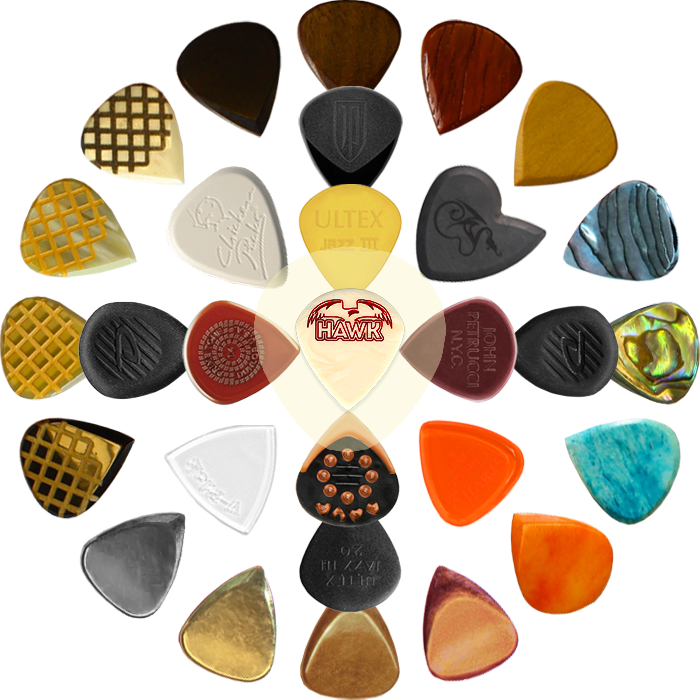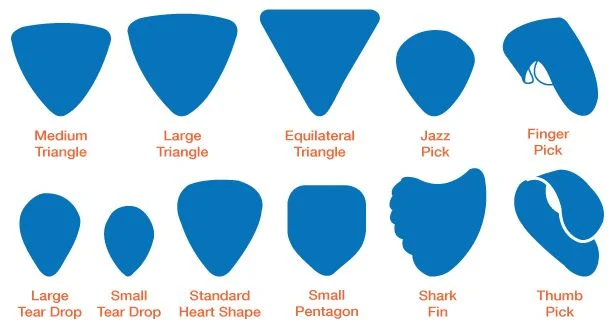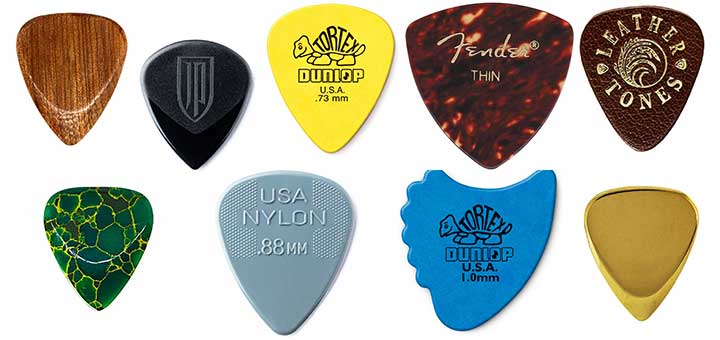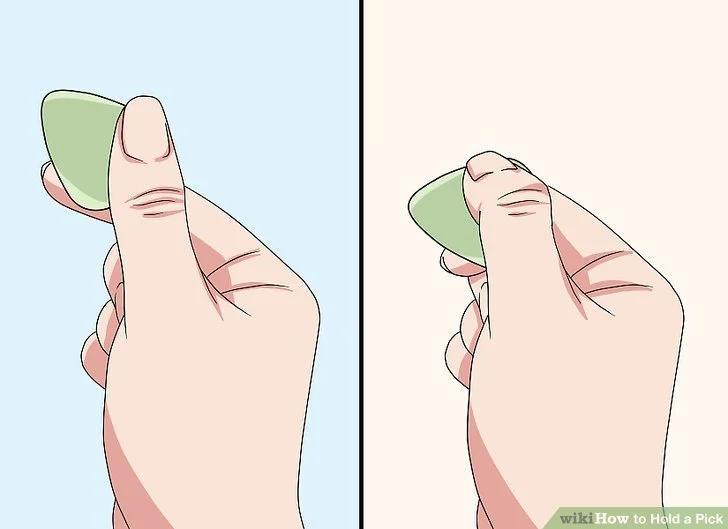Written by Metro Music Makers instructor Dr. Victor Ezquerra

When I first started playing 26 years ago, I bought almost every type of pick sold to try them out. I started off playing a classical guitar and when I didn’t fingerpick, I used a felt pick because I liked the delicate sound it produced and it was easy to hold. Once I began playing electric guitar, I switched to thin celluloid picks because they’re readily available, flexible, and have a snappy tone. Then, I switched to an aluminum thumbpick because it gave me the versatility to switch between fingerstyle and flatpicking effortlessly. Currently, I use pre-1965 quarters made into the size/shape of a jazz pick to play electric, thin nylon picks for steel-stringed acoustic, and continue to fingerpick using my nails.
Guitar picks can be vastly different depending on type, size, shape, thickness, brand, and material. It’s helpful to remember that you can use more than one type of pick, and you can always switch. Pick selection is not as big of a decision as buying a guitar and guitar picks are one of the cheapest aspects of playing—try out a bunch!
Below are some things to consider when choosing an appropriate pick. Bear in mind that the categories are interdependent and not independent. In other words, the material will affect the tone, the style of music will affect the shape of the pick you choose, etc.
SHAPE, SIZE AND TYPE OF PICK:

The picture above provides an overview of some different types and shapes of picks. Although the size and shape of the pick does change the tone, it affects technique the most. How you grip the pick, the speed of your picking, the power behind your strumming, and your style of playing can all be directly linked to the type of pick you play with. A major difference in types of picks is between flat picks (more commonly seen, gripped between the index finger and the thumb, and are just flat material with a point) and thumb or finger picks (which stay on individual fingers and presuppose you will be plucking with multiple fingers). The shape of the pick influences your grip and attack, the thickness of the pick directly relates to the “feel” of your picking and pushback from the strings, and the type of pick will determine your style of playing. If you are heavy-handed and frequently break picks, try out a thicker pick. If you get stuck on strings and want less resistance, try out a thinner pick. Find what works best for you.
MATERIAL:

Guitar picks are made out of almost any solid material that can be shaped into a pick. Material will affect strength and durability, the tone created, and the feel of the pick between your fingers. Various types of plastic are most common—celluloid, nylon, acetal. Plastic picks are cheap, can be made into almost any shape, and produce a defined, balanced tone. Other materials that used frequently are felt (easy to grip with sweaty fingers, produces a gentle and soft sound), metals (sharp, brilliant tone and aggressive attack), and woods (smooth, earthy sound and stiff). More unusual materials include stone, leather, shell, bone, glass, and nut. There is no “wrong” choice, so explore several options.
TONE AND STYLE:
The style of music you play, the type of guitar you’re playing on, and the tone you aim to create should all be considered when selecting a pick. It’s useful to consider the genre(s) of music you play, the style of your favorite guitarists, and the sounds you intend to create. Metal guitarists play in a tough, assertive style so they tend to use harder picks. Thin picks lend themselves to strumming chords and mellow playing. When exploring tonal differences, try to play the same song on the same guitar using different types of picks. Listen and feel for any differences. Try using the same pick on different guitars and see what changes. Music can sound completely different just from changing from one pick to another.
COMFORT AND FEEL:

Whatever pick you decide to play with, it should be practical and comfortable. It should feel good between your fingers and you should be able to play consistently without having it slip or dropping it. Picks have different textures: sanded picks feel more coarse or chalky and are less likely to slide out of your grip, polished picks glide off the strings easily but aren’t the best for sweaty fingers, and raised picks have bumpy areas that allow them to be grasped more firmly. Some picks have divots or cutaways that are intended to improve control, comfort, or accuracy for the player. Playing with a pick that is uncomfortable or doesn’t feel right can hinder your ability to play, and even deter you from playing at all. When a pick is properly selected it should feel “right” and add precision to your playing.
CONCLUSION:
If you play guitar with a pick, selecting a pick that works for you is an important decision that is frequently overlooked. A pick, or plectrum, contributes to playing guitar on several fronts. It initiates the sound coming from the guitar (which makes it an essential part of the instrument), it shapes the tone created by the guitar, it plays a large role in a player’s technique, and is something that often requires maintenance and/or replacement. Just like the bow is a vital component when playing violin or cello, the pick is a crucial aspect of playing guitar.
